LinkedIn might not be the most interesting topic to an aspiring filmmaker, but early in your career it can be incredibly effective, if used correctly.
LinkedIn is underutilized by most people. It’s easily one of the best ways to get in touch with high profile professionals. The median income on LinkedIn was $75,000 per year, in 2014. On Facebook, the median income was $35k per year. The stats speak for themselves.
LinkedIn is the best place to professionally connect, quickly and effectively. If you attend a local industry meet-and-greet with 1000 attendees, and have conversations no longer than 10 minutes each, you’ll connect with 18 people in three hours. Add some time afterward for sending each new connection a “nice to meet you,” email.
If you follow the process laid out in this guide, you’ll increase your chance of showing up at that same event and having 18 local professionals already know who you are.
I saw a huge jump in job offers after setting up my profile correctly, and you will will too. Setting up your profile can be the difference between appearing professional, or looking like a newbie.
I’m going to take you through the steps to make your LinkedIn really shine, plus what others in the industry are looking for. I’ll be writing this from the perspective of someone who is completely starting from scratch.
Before my first internship I had very few resources and really struggled to find help—LinkedIn changed that dramatically.
Within the film industry, it’s easy to feel helpless when trying to get going in the right direction. So here’s a breakdown of what I’ve learned about leveraging LinkedIn over the past few years. It’s long and technical, but following this guide closely will save you an incredible amount of time.
FILLING OUT YOUR PROFILE
By completely filling out your profile, you give yourself a much higher chance for success. The more relevant details you include in your profile, the higher the possibility your profile will resonate with those checking you out. Details legitimize your professional presence.
If you are completely starting from scratch and have almost nothing to list as experience, here are the exact steps you should take.
1) Include a photo.
LinkedIn profiles with photos are 11 times more likely to be viewed than those without. Tailor the photo to how you want to be perceived. It doesn’t have to be the most professional photo of yourself, but make sure you look friendly and engaging.
2) List any clubs you’re involved with.
Film clubs, acting classes, editing classes, anything relevant to the path you want to take. If you’re not involved in any clubs, join some! Meetup.com is a great place for finding clubs and groups to join and engage in.
3) Lynda.com is a fantastic resource for teaching yourself, on your own time.
If you’re lacking qualifications, Lynda is a quick way to get some on your profile. They’ll provide your LinkedIn profile with a certification once you’ve finished a course. You can find an abundant supply of courses to get started and make your profile look more professional.
Just a heads up, Lynda.com does come with a price—their basic listing is $25 / month, but you get your first 10 days free! I personally think it’s worth the price to bring a little credibility to your profile. Getting certified through Lynda.com is very straightforward as long as you use the same email address for both Lynda and LinkedIn.
When you complete a course, Lynda will send a link to your inbox which will sync with your LinkedIn account. Once you’ve synced accounts, you’ll receive a badge on LinkedIn that will reflect the work you’ve completed. Here are a couple examples from my personal profile:
4) You need to volunteer.
That’s the hard truth. Working in media is competitive and getting a paid gig right out of the gate probably won’t happen. By volunteering, you can get professional experience without waiting until paid jobs pop up. Your time is an investment.
If you can volunteer in return for a good LinkedIn recommendation, it is completely worth your time. You can find nonpaying jobs fairly easily on craiglist.org—look for free work in these categories:
Jobs:
tv / film / video
writing / editing
Gigs:
creative
crew
talent
Keep an eye on this daily and apply to everything, letting each lister know you’re working for free to build your resume.
Another great way to proactively find free work is by Googling: “production companies in *your city*”. Write a letter telling them you’re starting from scratch and want to intern. If they don’t have an intern program, offer to volunteer—anything to get going.
How much free work you do throughout your career is entirely up to you. There will come a point where you’ll need to get paid. In the beginning though, free work is essential to build up necessary experience, especially if you have little to no local industry contacts.
5) Recommendations are important if you have thin work experience.
I’m not saying you should go out and beg for undeserved recommendations, but if you get one from a trusted source it can go a long way for your social proof. Social proof is a marketing term, but really you are marketing yourself. Think of your own purchasing decisions: when you’re checking something out on Amazon, what do you usually look at?
I know I check out the reviews, and I’m not alone. In fact, 70% of people do the same exact thing when they’re looking to buy something.
Now think of the connections looking at your LinkedIn profile: I guarantee most people will scroll down and look at your recommendations and endorsements. The best way to start getting endorsements from others on LinkedIn is by giving endorsements to others in your network.
People will often feel a need to repay you by giving an endorsement of their own.
You can always simply reach out to people and ask for endorsements. If you worked with someone and did a good job, there’s no reason why they wouldn’t give you a good public recommendation. As long as you are giving people the value of your hard work, they will be happy to repay you.
Once you’ve worked a couple gigs, start reaching out to those you worked for and tell them this:
Hi __________,
I was wondering if you could give me a recommendation on LinkedIn? I know you have a busy schedule, but it would help my profile stand out. If you don’t have the time, no problem. Thanks so much, hope you’re doing well!
*Your name*
6) Linking to your past work or portfolio is a must.
From what I see, not a lot of people utilize this on LinkedIn, even in the entertainment industry, and it boggles the mind. If you work on cool projects, link to them! It gives your profile an edge, and this is one reason LinkedIn is superior to a resume. Here’s a another screen grab from my LinkedIn:
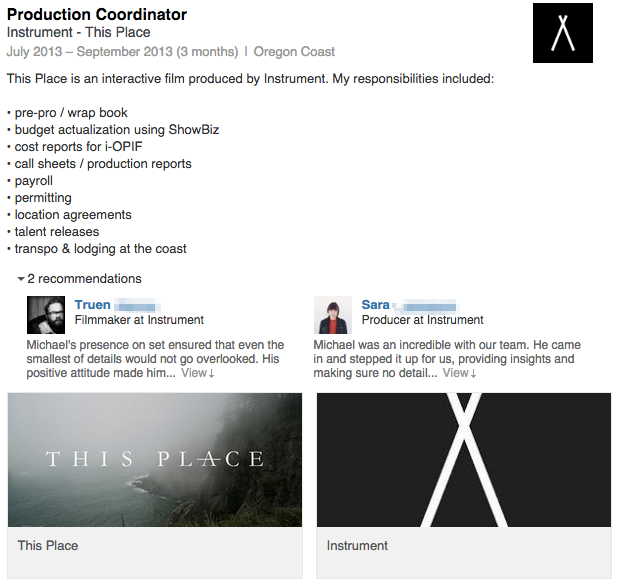
Recommendations look fantastic and can link to the piece of content you’re referencing. It’s a very easy process that pays off significantly. Here are a few more screenshots to show you additional examples of how to do this:
A. Log in to your LinkedIn account and click “Edit Profile” under the “Profile” header.
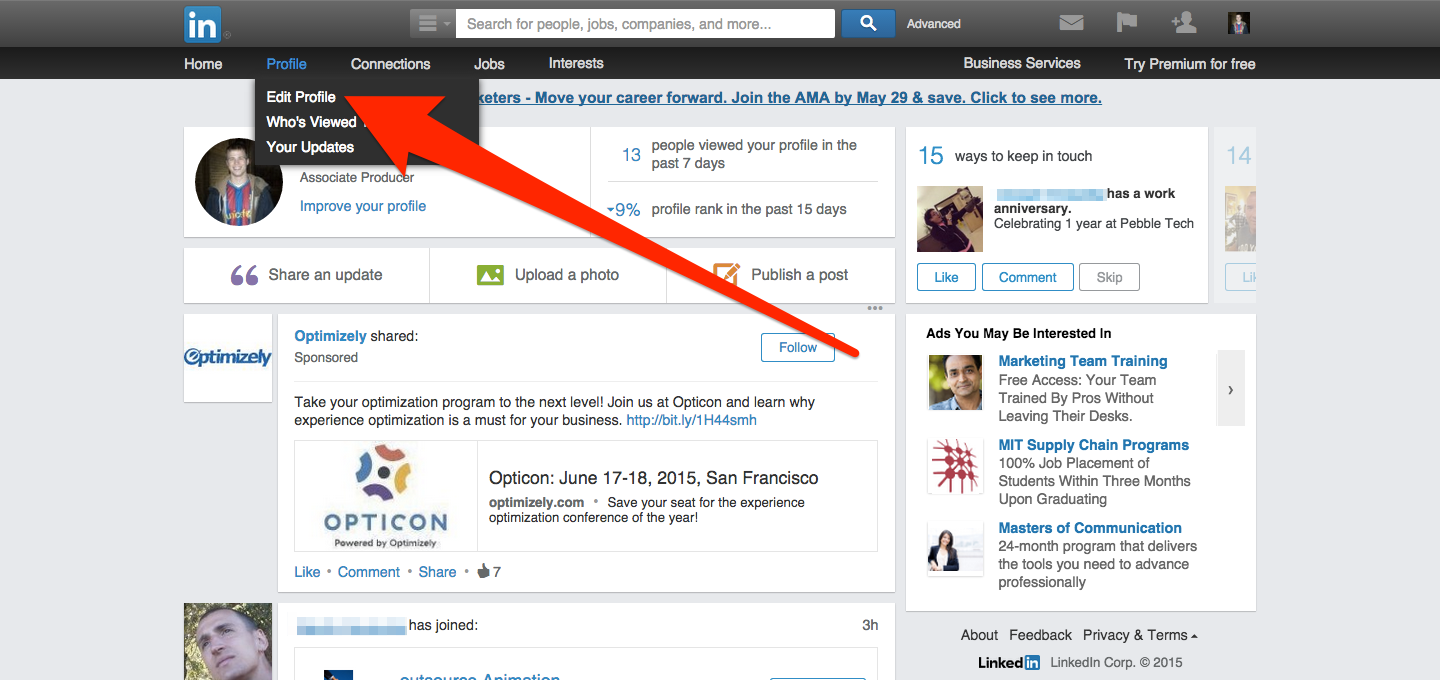
B. Scroll down to the “Experience” section of your profile and hold your cursor over it. A few icons should appear at the very top-right, above the last position you’ve listed. Click the button in the middle—the one that looks like a rectangular box with a plus sign in its bottom-right corner.

C. This will pop open a box that will allow you to pick any of your past positions and associate a link with a specific job. You also have the choice of uploading files, which is great if you want to display past letters of recommendation, portfolio pieces, writing samples, etc.

7) Get your own LinkedIn URL.
This is important for lots of reasons, but it’s primarily great for your email signature or on a physical resume. It’s pretty easy to customize: if you click the “Edit Profile” tab again, there will be a section right under your profile picture. Click this and you’ll be able to customize your URL. I would suggest making the extension your name, so it’s easy to remember for you AND your connections.
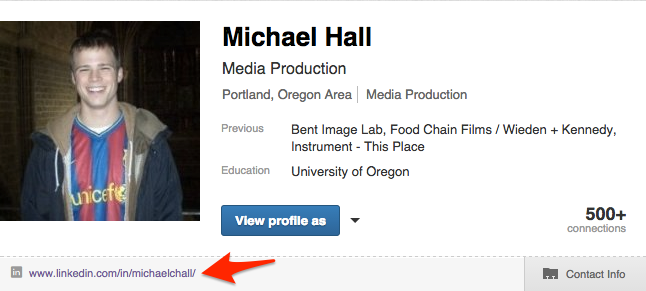
CONNECTING WITH OTHERS
Though it’s important to connect within your immediate circle—as with Facebook and other social platforms—your biggest priority is connecting within your industry. There are a few quick and effective ways to do this.
It’s important to have your LinkedIn profile well fleshed out, because I’m about to show you how to connect with literally thousands of people in just a few minutes, getting many eyes on you and your profile.
While I’m not actively looking for work, I wanted to demonstrate how many people you can push to your page. This was the only tactic I used, and you can see a huge spike in my profile views on the day I implemented it:
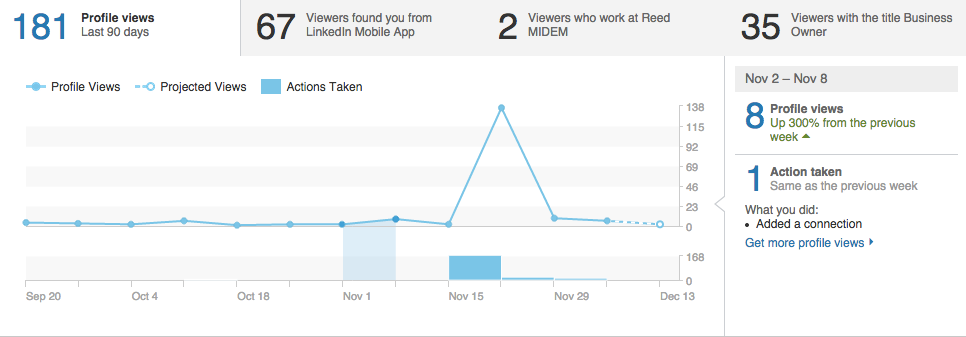
As you can see, I had 138 pageviews in one day. I only had a total of 181 views in the prior 90 days. That’s more than 76% of my pageviews from the last three months, in one day. This tactic is incredibly effective for driving people to your profile. From there, it’s up to you to keep them engaged.

This was from someone fairly high up in the production world, who saw my profile and skill set, and decided to reach out. It’s a pretty informal message, but a meaningful one, considering the person’s stature. Here are the steps I recommend to get these results:
Crew directories are something I talk a lot about because of how useful they can be when starting. A crew film directory is exactly what it sounds like: a list of crew members in a city that have submitted their email addresses and phone numbers to a directory. This is done because it’s a streamlined way to find freelancers for hire, but I use it in a variety of other ways—the first of which I’ll talk about in step two.
2) Use a tool called, “Email Grabber 2.”
It costs $16.95, and it’s fantastic; I use it all the time. It also comes with a free trial, so you can give it a spin before throwing any money down. Email Grabber pulls addresses from websites. This is the perfect tool if you want to grab a lot of email addresses from, oh, I don’t know, a directory? So once you’ve downloaded Email Grabber, follow these steps:
A. Open Email Grabber 2 on your desktop. Your screen should look like this.
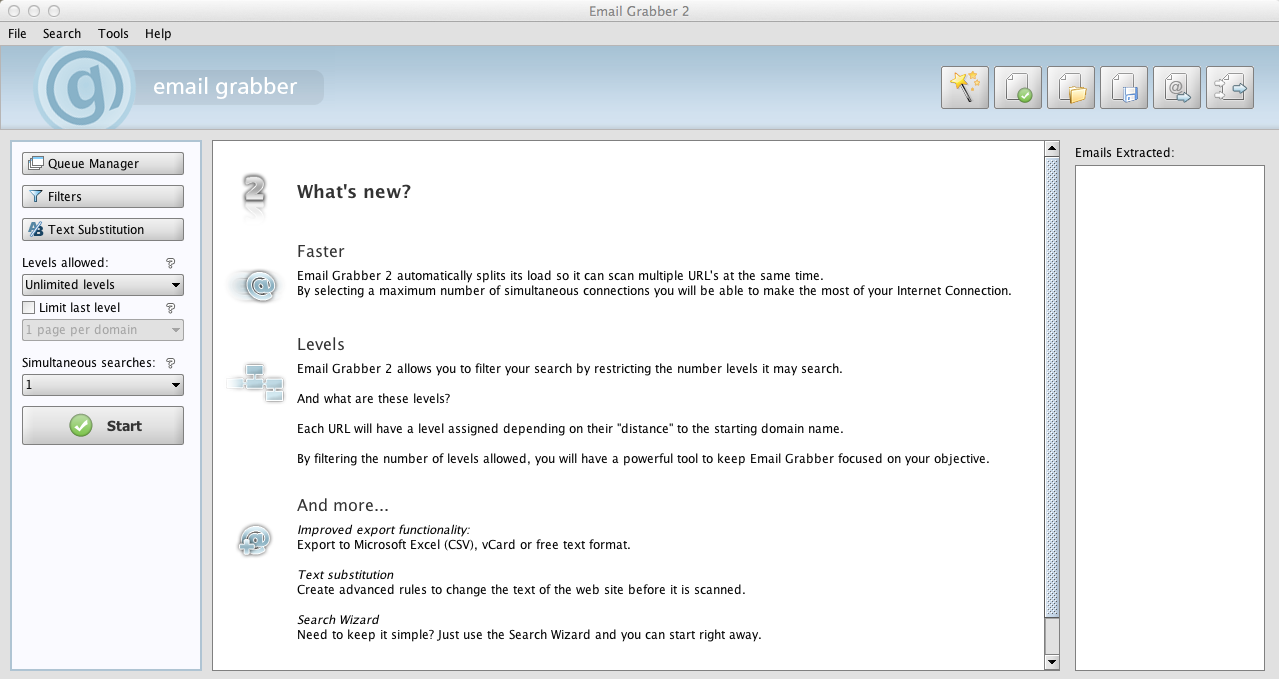
B. As you can see, the tabs on the far left control this entire process. Start by clicking the “Levels Allowed” tab. A “level” represents how deep you want Email Grabber to dig for an email address. Email Grabber can mine pretty deep for emails on websites, but keep the search laser focused since you’re only looking to make connections with professionals in your area.
Click, “0 – Starting Website Only.” Again, this ensures you’re only grabbing emails from the primary database of emails.
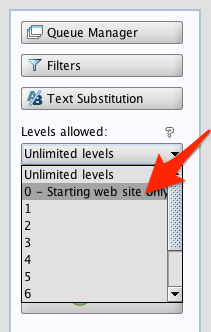
C. Now, click “Queue Manager” in the top left of your screen.
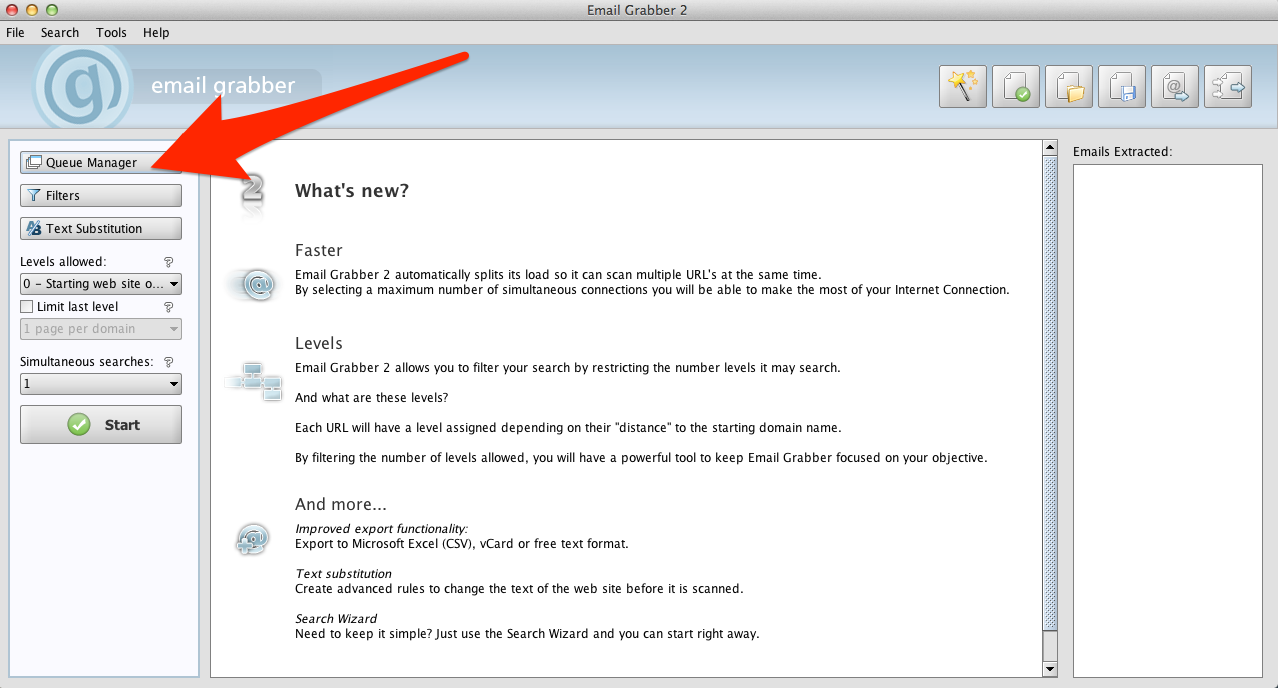
D. The Queue Manager is where you will add the link to your local directory. I suggest digging down to the “crew” section of your local directory and copying & pasting its exact URL, since these will be the most relevant email addresses for your LinkedIn connections. For this example I’m using my local directory, Source Oregon.
Paste the directory URL into the box and click, “Add”.
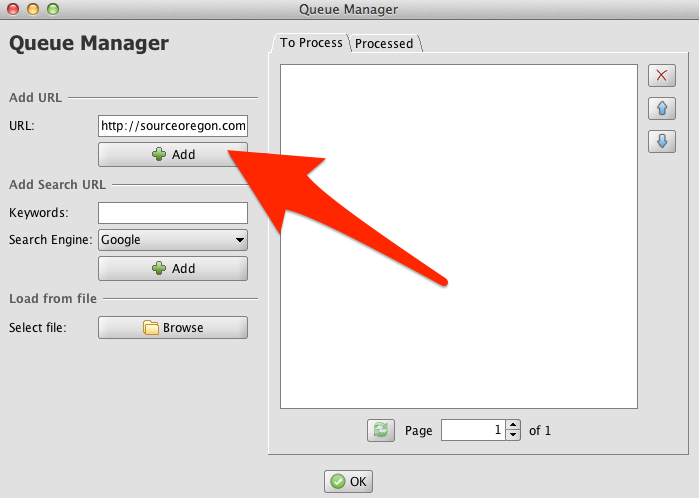
E. Click OK.
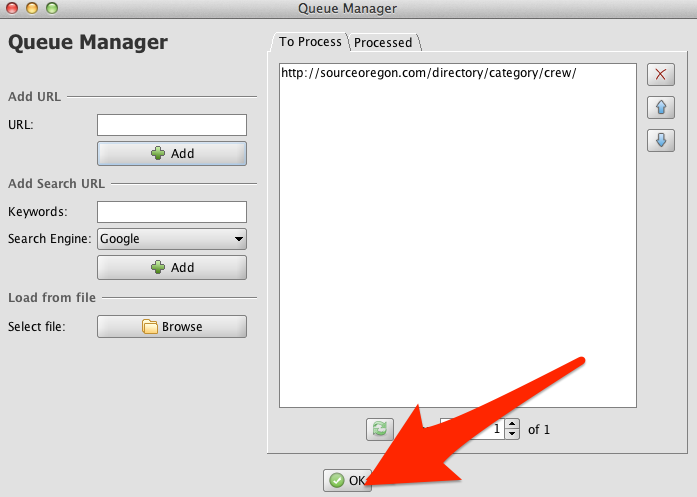
F. This will take you back to your home screen. From here, click Start, which will begin populating the “Emails Extracted” area on the far left. It might take awhile to gather all the email addresses, so take a break and check on it in an hour or so.
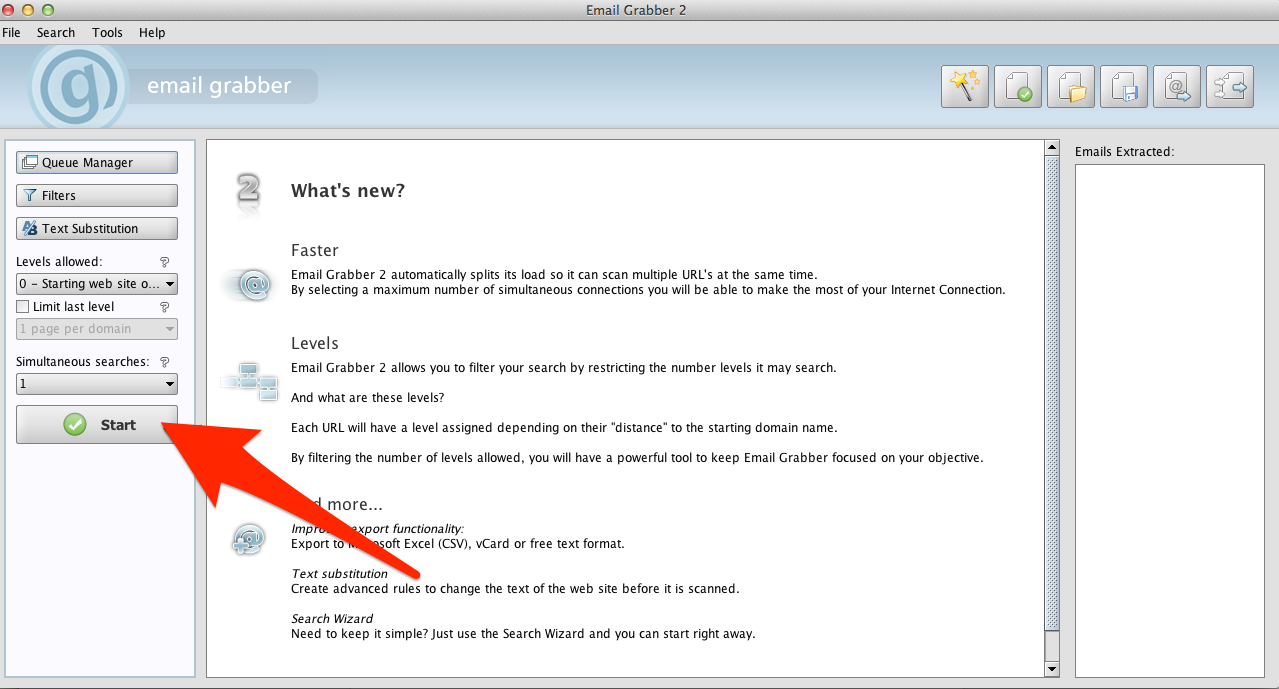
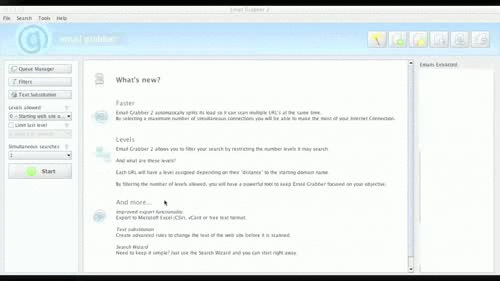
G. Once the software finishes, a notification will pop up on your screen.

H. Export the email addresses by clicking the button second in from the right, in the upper-right corner.

I. This will pop open a window, giving you a range of exporting options. Click the middle box, “CSV”, because this will be the most compatible option for uploading directly to LinkedIn.
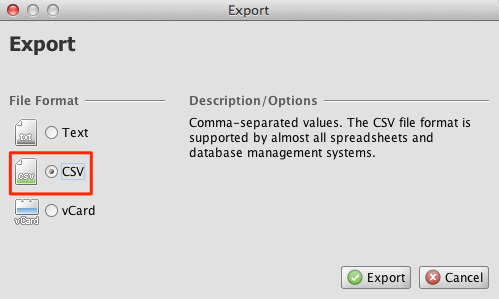
J. Click Export.

K. Make sure you save the CSV somewhere like your desktop, so you can grab it easily.

L. Log into your LinkedIn profile, navigate to the “Connections” tab, hover over it, and click the “Add Connections” button.
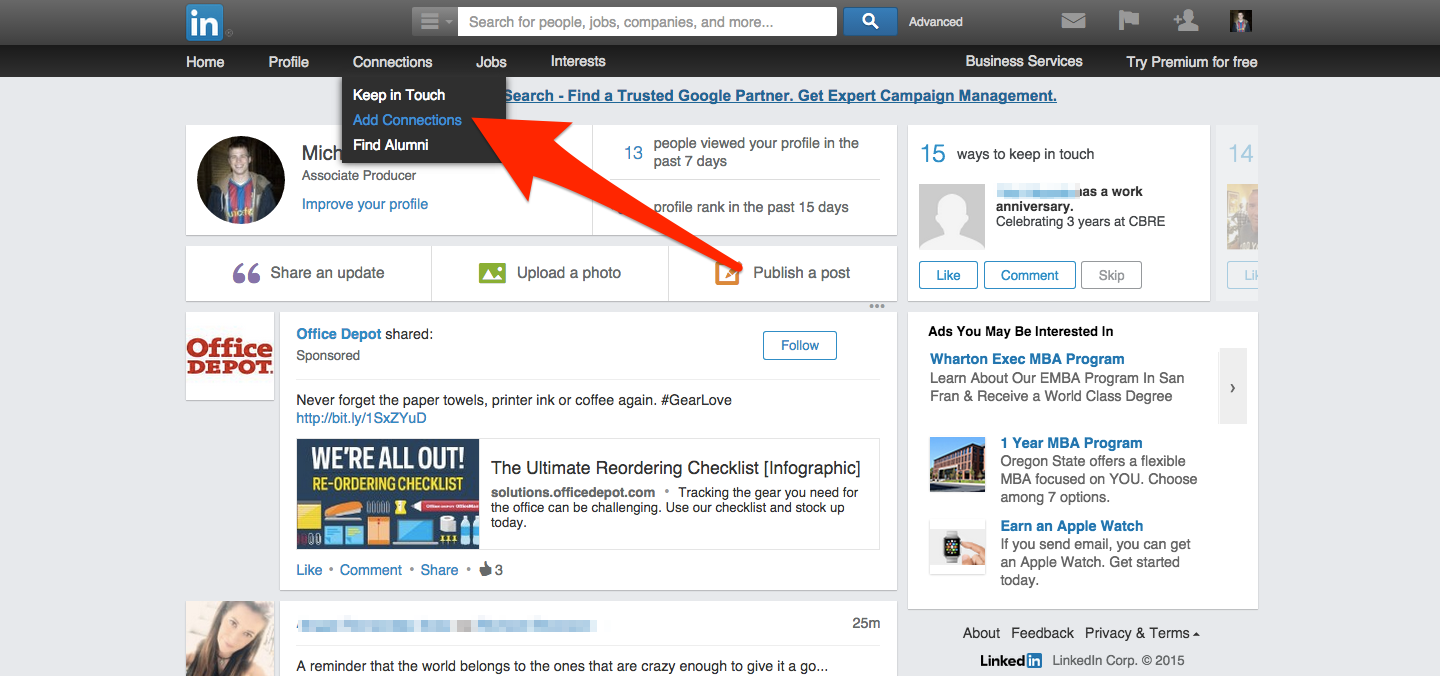
M. Click the button that says “Any Email.”
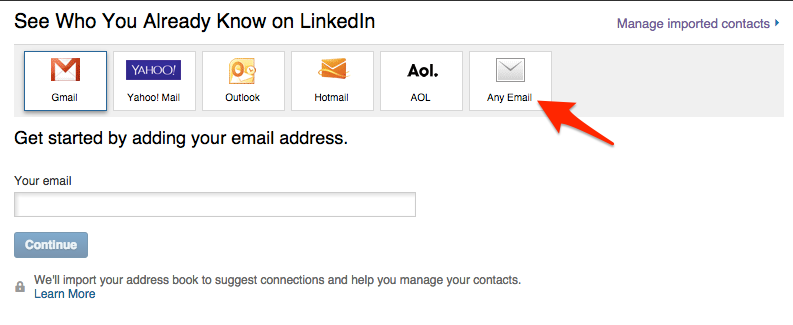
N. Here, you can directly upload the emails you just gathered from the directory. Click “Upload contacts file.”
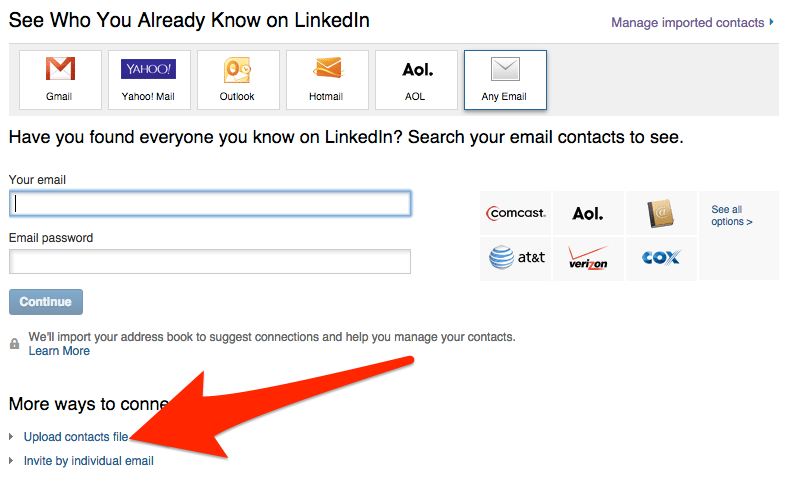
O. Choose the CSV you saved from Email Grabber, and upload your file.

P. Click “Add Connections.”

![]()
There you go! That’s the process for a “shotgun” approach to connecting with a large volume of relevant and interested folks. Here is what my notifications looked like within minutes of going through the steps I outlined above:
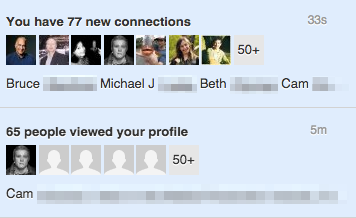
You will see the residual effects of this process weeks after you try it. You’ll get a lot of eyes on your profile, which is why it’s important to stand out. When your new connections accept your invitation, I strongly suggest reaching out and thanking them.
Keep it short and personal. If it’s someone you really think would be good to know, reach out and ask for an informational interview, and you’ll be well on your way!
THE TAKEAWAY
Using LinkedIn correctly can lead to amazing results. With the right combination of profile content and outreach, you can do in a single day what used to take months.
Right now, LinkedIn is a much smaller pool than other leading social networks, and its focus on working professionals makes it indispensable to you. What I’ve outlined in this post is the best way to hit the ground running and build an online reputation. Couple that appearance with hard work, and you’ll be on your way to a career in no time!
What do you think? I would love to hear your thoughts in the comments. 🙂 Let me know how this worked for you!
PS: Give me a shout on LinkedIn!
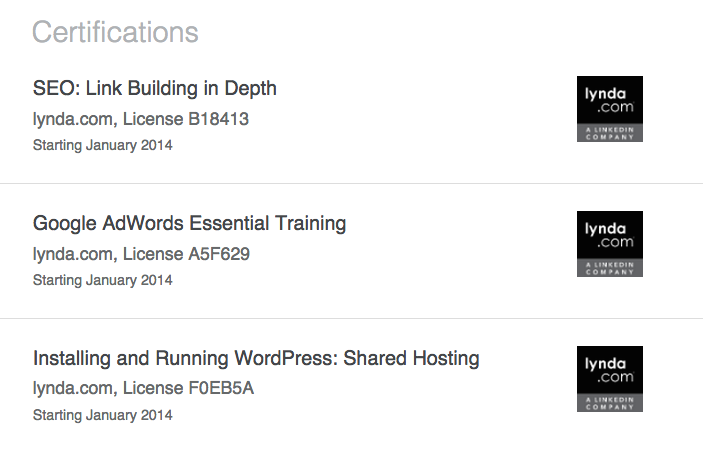
I get what you’re saying, but workng for free is bullshit.
Hey Zaza!
I hear where you’re coming from and there is definitely a thin line between interning / volunteering and providing hours of free labor, which isn’t right. This is definitely a hot issue and was really called into question with the Black Swan case last year.
Is there a point where production companies start to exploit free labor? Yes. But the fact is that everyone I know that has been successful in this industry has either interned or volunteered to build their resume. I wrote this post speaking from my experience and what has worked for me.
I think that you always need to evaluate where you are in your career and decide the right choice for yourself. At this point in my life there is no way I would work for free, but four years ago it was a completely different story. It’s also important to note that you can find a lot of volunteer / intern programs for only a few hours a week so you CAN make money elsewhere. That’s exactly what I did!
Hope that helps!
A good producer not only makes good films, but makes money for the investors. Like most jobs in the film industry, producers work their way up. You might start as a production assistant or a script reader, learning how to spot a good idea and how to bring it to fruition.
So true, good call Dyson!